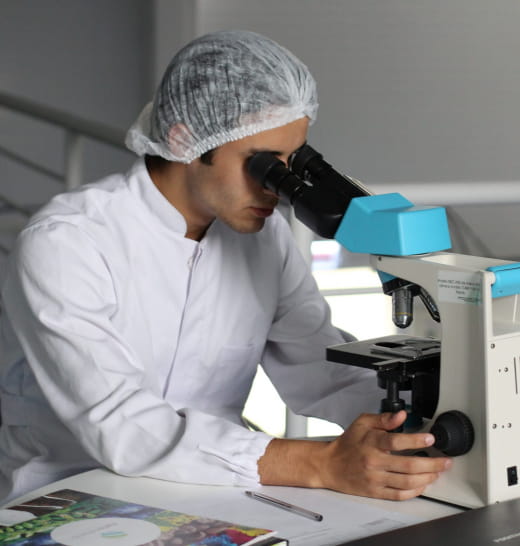Created in January 2012, the Microenvironment, Signaling and Cancer (MicroCAN) team studies the role of the extracellular matrix and the inflammatory microenvironment in tumor biology. Our activities are oriented towards a better understanding of metastasis and treatment resistance in cutaneous melanoma and we integrate basic, preclinical and translational research approaches. We also explore the tumor-stroma dialogue within the lymphatic niche, the main site of melanoma metastasis and resistance of lymphoid neoplasia. A transversal core program of the team concerns signaling by protein tyrosine kinases such as DDR1/2 or SYK and deubiquitinating enzymes (DUBs) in inflammation and cancer.
Over the last few years, using a multidisciplinary and collaborative approach combining cell biology, biomechanics and omics, our team has contributed to significant advances in the microenvironmental regulation of tumor cell plasticity, therapy escape and cell signaling.

Projects

S. Tartare-DeckertResearch Director
Mail Sophie.TARTARE-DECKERT@univ-cotedazur.fr

M. DeckertResearch Director
Mail marcel.deckert@univ-cotedazur.fr

C. GirardResearcher
Mail christophe.girard@univ-cotedazur.fr
Our data attribute a novel role to the mechanical and fibrotic environment in the adaptation and therapeutic resistance of melanoma cells and establish an original link between the physicochemical properties of the extracellular matrix and the biology of melanoma cells.
Therapeutic inhibition of the BRAF oncogenic pathway in vivo induces a reprogramming of the matrix that leads to a stiffening of collagen, promoting the formation of resistance sites and metastatic relapse. The objectives of this project are to improve our knowledge of the mechanical dialogue between tumor cells and the matrix network, and to better understand the processes involved in the phenotypic and metabolic plasticity within the resistance niches. In this project, we are studying the involvement of actors that we have identified (collagen receptor DDR1/2 and pro-fibrotic cluster miR-143/145) and, in parallel, we are conducting global transcriptomic, metabolomic and proteomic analyses in order to identify new regulatory pathways involved in responses to stiffness changes and their role in the biology of melanoma cells.

O. BouvetPhD student
Mail oceane.bouvet@univ-cotedazur.fr

A. CarminatiPost-doctoral fellow
Mail alexandrine.carminati@univ-cotedazur.fr

M. KAHILPhD student
Mail Mira.KAHIL@etu.univ-cotedazur.fr

M. OhannaResearcher
Mail mickael.ohanna@univ-cotedazur.fr

E. PICHERYResearch engineer
Mail Estelle.PICHERY@univ-cotedazur.fr

S. Tartare-DeckertResearch Director
Mail Sophie.TARTARE-DECKERT@univ-cotedazur.fr

M. DeckertResearch Director
Mail marcel.deckert@univ-cotedazur.fr

V. PROD'HOMMEResearcher
Mail Virginie.PROD'HOMME@univ-cotedazur.fr

Metastatic lymphatic niche
Lymph nodes play an important role in the natural history of melanoma and provide a particularly favorable and specialized environment for metastasis at the matrix and cellular level. While there is a large body of work demonstrating how tumor cells interact with fibroblasts within the primary tumor, much less work has been done on the tumor-draining lymph node.
The mechanisms by which melanoma cells reprogram their transcriptome to adapt and survive within the lymphatic niche during lymph node colonization remain poorly characterized. Our hypothesis is that the lymphatic stroma and fibroblasts in particular influence the phenotypic plasticity related to the survival and therapeutic resistance of melanoma cells, as well as their ability to disseminate at a distance. In this project, we aim to understand how fibroblast reprogramming and matrix network remodeling impact tumor progression in the lymphatic niche.

A. CarminatiPost-doctoral fellow
Mail alexandrine.carminati@univ-cotedazur.fr

M. ChapeauPhD student
Mail melissa.chapeau@univ-cotedazur.fr

F. LARBRETResearch engineer
Mail frederic.larbret@univ-cotedazur.fr

W. MohagerResearch engineer
Mail Walaa.MOHAGER@univ-cotedazur.fr

M. DeckertResearch Director
Mail marcel.deckert@univ-cotedazur.fr

S. Tartare-DeckertResearch Director
Mail Sophie.TARTARE-DECKERT@univ-cotedazur.fr

M. OhannaResearcher
Mail mickael.ohanna@univ-cotedazur.fr
In melanoma, the mutational burden due to UV exposure and a high proliferation index increase the dependence on mechanisms controlling proteotoxic stress, such as the ubiquitin-proteasome system (UPS). Targeting the UPS therefore represents a promising strategy against advanced and metastatic melanoma. The opposite reaction to ubiquitin conjugation is deubiquitination by proteases called DeUBiquitinases (DUBs). A strategy based on pharmacological and genetic screens has allowed us to identify several DUBs as drivers of melanoma cell survival, proliferation and drug tolerance. The objective of this project is to better understand the role of the identified DUBs in the biomechanical and metabolic reprogramming of melanoma and the therapeutic response.

O. BouvetPhD student
Mail oceane.bouvet@univ-cotedazur.fr

F. LARBRETResearch engineer
Mail frederic.larbret@univ-cotedazur.fr

E. PICHERYResearch engineer
Mail Estelle.PICHERY@univ-cotedazur.fr
Publications
Focus
A Feed-Forward Mechanosignaling Loop Confers Resistance to Therapies Targeting the MAPK Pathway in BRAF-Mutant Melanoma.Authors Girard CA, Lecacheur M, Ben Jouira R, Berestjuk I, Diazzi S, Prod'homme V, Mallavialle A, Larbret F, Gesson M, Schaub S, Pisano S, Audebert S, Mari B, Gaggioli C, Leucci E, Marine JC, Deckert M, Tartare-Deckert S
Cancer research May 2020
Blockade of the pro-fibrotic reaction mediated by the miR-143/-145 cluster enhances the responses to targeted therapy in melanoma.Authors Diazzi S, Baeri A, Fassy J, Lecacheur M, Marin-Bejar O, Girard CA, Lefevre L, Lacoux C, Irondelle M, Mounier C, Truchi M, Couralet M, Ohanna M, Carminati A, Berestjuk I, Larbret F, Gilot D, Vassaux G, Marine JC, Deckert M, Mari B, Tartare-Deckert S
EMBO molecular medicine Feb 2022
Other recent publications
Impact of rising seawater temperature on a phagocytic cell population during infection in the sea anemone .Authors Billaud M, Larbret F, Czerucka D
Frontiers in immunology Dec 2023
Nanoblades allow high-level genome editing in murine and human organoids.Authors Tiroille V, Krug A, Bokobza E, Kahi M, Bulcaen M, Ensinck MM, Geurts MH, Hendriks D, Vermeulen F, Larbret F, Gutierrez-Guerrero A, Chen Y, Van Zundert I, Rocha S, Rios AC, Medaer L, Gijsbers R, Mangeot PE, Clevers H, Carlon MS, Bost F, Verhoeyen E
Molecular therapy. Nucleic acids Jul 2023
The mechanical phenotypic plasticity of melanoma cell: an emerging driver of therapy cross-resistance.Authors Diazzi S, Tartare-Deckert S, Deckert M
Oncogenesis Feb 2023
Show all publicationsPatents
Co-inventors S. Tartare-Deckert, M. Deckert, S. Diazzi, B. Mari
Co-inventors M. Deckert, M. Ohanna, S. Tartare-Deckert, P. Biber
Co-inventors S. Tartare-Deckert, M. Deckert, M. Rathore, M. Tichet
News
20 June 2022 - La Ligue Nationale Contre le Cancer
Our team has benefited from two labellisations from the Ligue Nationale Contre le Cancer since 2016. This support has enabled us to identify different mechanisms involved in the resistance to treatment and the metastatic dissemination of melanoma with, as a result, several avenues for improving the management of the disease.

January 2022 - Nice-Matin newspaper



